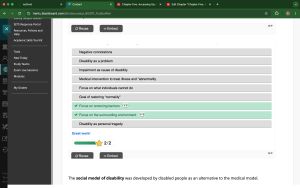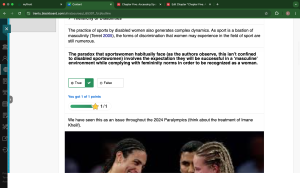5
Section one: The fundamentals
A)
Exercise 1: Notebook Prompt
Many of you are likely familiar with the concept of “ability inequity,” which the authors of this article define as “an unjust or unfair (a) ‘distribution of access to and protection from abilities generated through human interventions’ or (b) ‘judgment of abilities intrinsic to biological structures such as the human body’.”
However, they go on to identify the following “ability concepts” that are less familiar:
1) ability security (one is able to live a decent life with whatever set of abilities one has)
2) ability identity security (to be able to be at ease with ones abilities)
How prevalent are these forms of security among disabled people you know? Or, if you identify as a disabled person, would you say your social surroundings and community foster and support these kinds of security? Furthermore, while the focus of the article is on Kinesiology programs, it is also important to reflect on how academia in general accommodates for disability. If you feel comfortable answering this question, what has been your experience of postsecondary education to date?
-OR-
The authors also observe that “Ableism not only intersects with other forms of oppression, such as racism, sexism, ageism, and classism, but abilities are often used to justify such negative ‘isms’.”
What do you think this means? Provide an example.
| This paragraph highlights the close connection between “ability”, both physical and cognitive, and questions of justice, equity, and identity. It also highlights how ableism, or discrimination based on ability, is not a standalone phenomenon. Rather, it is frequently intertwined with other types of oppression, such as ageism, classism, sexism, and racism. The authors demonstrate how society favours some skills over others and how this preference is exploited to excuse exclusion or discrimination.
It implies that people’s perceived or real abilities, whether they are innate or acquired, are frequently used to determine their value or potential. When this decision is discriminatory or unfair, it leads to “ability inequity.” In addition to being excluded, persons who don’t meet prevailing standards of competence may also be encouraged to doubt their identity or their entitlement to a happy existence. When ableism coexists with other types of oppression, this becomes worse. For instance, when stereotypes and discriminatory behaviours overlap, people who are both disabled, and members of a racial minority may experience greater levels of marginalization. An example of this could be an Asian girl with a learning disability in a low-income school. She may be perceived as less capable or intellectual due to racial and gender biases in addition to her disability. She could not have the same options as her peers or be directed into a lower academic stream. In this instance, racism, sexism, classism, and ableism all come together, and the unfair treatment is justified by her abilities, or perceived lack thereof. She may also lack “ability identity security”, that is, she may find it difficult to feel comfortable or secure in her skills as a result of continual exclusion and comparison. Additionally, without “ability security,” she could not have access to resources that help her succeed, such as inclusive extracurricular activities, mentorship, or modified learning materials.
|
Exercise 2: Implicit Bias Test
Did anything surprise you about the results of the test? Please share if you’re comfortable OR comment on the usefulness of these kinds of tests more generally.
| A helpful tool for raising self-awareness of unconscious biases is the Harvard Implicit Association Tests (IAT). These assessments seek to identify implicit attitudes or preconceptions that people may harbor, frequently without being aware of how they affect behavior or decision-making. When evaluated, for instance, a person may have a preference for one race, gender, or body type over another despite believing they are impartial.
The IAT can encourage critical thought even though it cannot accurately gauge personal prejudice or forecast a person’s behavior. It assists users in identifying the ways in which cultural conditioning and societal messaging may have influenced their thoughts. A crucial first step in combating ingrained prejudices and encouraging more inclusive conduct is raising awareness of this issue. Critics counter that the test’s validity and reliability can change and that the results can change based on mood or context. As such, it should be utilized as a teaching prompt rather than a diagnostic tool. Overall, the IAT is most effective when combined with ongoing discussion, deeper learning, and structural change. Although it’s not a solution, it can lead to fruitful discussions about privilege, racism, and our collective responsibility to build more equal societies.
|
B) Keywords
Exercise 3:
Add the keyword you contributed to padlet and briefly (50 words max) explain its importance to you.
| Medical model of disability:
According to the medical model of disability, a person’s physical, mental, or sensory deficits are the root cause of their disability. Its main goals are diagnosis, therapy, and “fixing” the individual so they can operate normally. Instead of taking social or environmental elements into account, this paradigm assumes that the primary obstacle to involvement in society is the individual’s condition. Because of this, it frequently ignores the ways that systemic inequity, inaccessible environments, and societal attitudes all contribute to disability. Critics contend that this strategy fails to foster inclusion and instead perpetuates stigma, advocating for strategies that emphasize social transformation and empowerment.
|
B) On Disability
Exercise 4: Complete the Activities



Exercise 5: Notebook Prompt
What do Fitzgerald and Long identify as barriers to inclusion and how might these apply to sport in particular?
One significant obstacle is attitudes; many non-disabled individuals, such as coaches and sport administrators, frequently have preconceived notions about the abilities and limitations of disabled people. These presumptions may result in discriminatory actions, such failing to modify facilities or programs to meet the requirements of diverse groups.
They also highlight systemic obstacles like inadequate transportation, a dearth of accessible facilities, and laws that do not give inclusive design top priority. Because of them, it is physically challenging for people with disabilities to access sports and recreational areas.
Institutional and organizational obstacles are also important. These include inadequate finance for inclusive programs, a shortage of trained personnel, and an emphasis on competitive or elite sport rather than inclusive recreational or participatory models.
Particularly in sports, these hurdles are frequently exacerbated by a prevailing culture that values competitiveness, physical prowess, and able-bodied success. Instead of providing fully integrated, inclusive opportunities that celebrate a range of bodies and abilities, this might belittle disabled athletes and perpetuate segregation through distinct programs.
C) Inclusion, Integration, Separation
Exercise 6: Complete the Activities


Exercise 7: Notebook Prompt
Choose ONE of the three questions Fitzgerald and Long argue disability sport needs to address and record your thoughts in your Notebook.
- Should sport be grouped by ability or disability?
- Is sport for participation or competition?
- Should sport competitions be integrated?
The authors argue that while disability-based groupings might provide safe, encouraging environments and fair competition, they can also serve to further isolation and the idea that athletes with disabilities are not welcome in mainstream sports. Fitzgerald and Long stress that categorization shouldn’t be strict. Since some disabled people may thrive in specialized surroundings while others may prefer integrated ones, inclusion should instead be flexible and context-specific. Prioritizing liberty, choice, and access is crucial. If done carefully and with an emphasis on skill level and participation goals rather than labels, grouping people by ability rather than by disability can be more inclusive. If aids and modifications are not offered, this strategy may still disadvantage athletes with disabilities if it is not carefully thought out. Fitzgerald and Long contend that neither model is fundamentally superior and that what counts most is the way sport structures are created and the people they include or exclude. It is necessary to question ableist presumptions and develop varied pathways that enable everyone, regardless of ability, to engage in meaningful sport participation in order to achieve true inclusion.
|
Part Two: Making Connections
A) Gender, Sport and Disability
Exercise 8: Complete the Activity
The paradox that sportswomen habitually face (as the authors observe, this isn’t confined to disabled sportswomen) involves the expectation they will be successful in a ‘masculine’ environment while complying with femininity norms in order to be recognized as a woman.
True or false?

Take a moment to reflect on this paradox below (optional).
B) Masculinity, Disability, and Murderball
Exercise 9: Notebook/Padlet Prompt
Watch the film, Murderball and respond to the question in the padlet below (you will have an opportunity to return to the film at the end of this module).
The authors of “Cripping Sport and Physical Activity: An Intersectional Approach to Gender and Disability” observe that the “gendered performance of the wheelchair rugby players can…be interpreted as a form of resistance to marginalized masculinity” (332) but also point out that it may reinforce “ableist norms of masculinity.” After viewing the film, which argument do you agree with?
a) Murderball celebrates a kind of resistance to marginalized masculinity
| d) Murderball does both of these things:
Murderball effectively illustrates how wheelchair rugby players display strength, toughness, and competitiveness, elements commonly associated with dominant forms of masculinity, in order to combat the marginalization frequently associated with disability. In this way, the movie honors a rejection of the notion that men with disabilities are asexual, weak, or meek. It allows these athletes the freedom to recover their masculinity, dignity, and identity as they see fit. However, by promoting characteristics like violence, physical dominance, and emotional stoicism as indicators of value, the movie also upholds ableist standards of masculinity. It frequently promotes a limited definition of masculinity that could leave out more varied manifestations, both inside and beyond the disabled population. Overall, Murderball is a complicated and multi-layered portrayal that both resists and reinforces, breaking down barriers while upholding certain conventions.
|
Section Three: Taking a Shot
A) Resistance
B) Calling out Supercrip
Exercise 10: Mini Assignment (worth 5% in addition to the module grade)
1) Do you agree with the critique of the “supercrip” narrative in this video? Why or why not? Find an example of the “supercrip” Paralympian in the 2024 Paris Paralympics or Special Olympics coverage and explain how it works.
|
|
2) Does the film Murderball play into the supercrip narrative in your opinion? How does gender inform supercrip (read this blog for some ideas)?
(300 words for each response)
|
|

